Ox bone soup is very popular all year round in Korea, but especially in the winter. This is my mother’s recipe. When I was young, sometimes in the winter she used to make us drink it every morning and every night until we got tired of it. “It’s good for your body, take some, you will grow taller” : )
In Korea, ox leg bones (called sagol 사골) are very expensive. When I came to America for the first time about 20 years ago, I couldn’t believe these bones were so cheap!
The milky broth is achieved by simmering for hours and hours. There’s no rule for how many hours you have to boil it, but you need simmer until you get a milky broth, and the bones are smooth with no more meat sticking to them. All the bone marrow should be boiled away so that there’s a cavity in the center of each bone. The inside of the bones should look like a sponge.
Koreans like to joke that if a Korean husband sees his wife making this soup, he starts to get nervous. He knows he’s going to be eating the soup for days or even weeks!
“Why she is making this? Is she going to leave home for days? Maybe she will visit her parents or take a trip with her friends?”
So, when he sees the wife boiling bone soup, he may say ask: “Where are you going?” : )
It’s served with rice and kimchi; you don’t need many side dishes when you serve this. If you keep this soup in the fridge, and warm rice in the rice cooker, and some kimchi and beef portioned out in the fridge, you’ll have instant meals for a long time, all you have to do is heat it up. I heard that some American housewives do a similar thing with lasagna. They make a big batch before they go away, so their husbands and children will have delicious food to eat until they come back.
Don’t ask me: “Maangchi, I want to make only 1 bowl of this soup.” This is the smallest batch of ox-bone soup that I can imagine! I used to make it with 10 pounds of bones: ) So just make a lot, and eat it over a few days.
Ingredients (for 6 servings)
2½ pounds of ox bones, 2 pounds beef flank (or brisket or round), water, Korean radish (or daikon radish), onion, green onions, kosher salt, black ground pepper, toasted sesame oil.
Directions
- Soak the ox bones and the beef in cold water for 20 minutes to remove any blood.
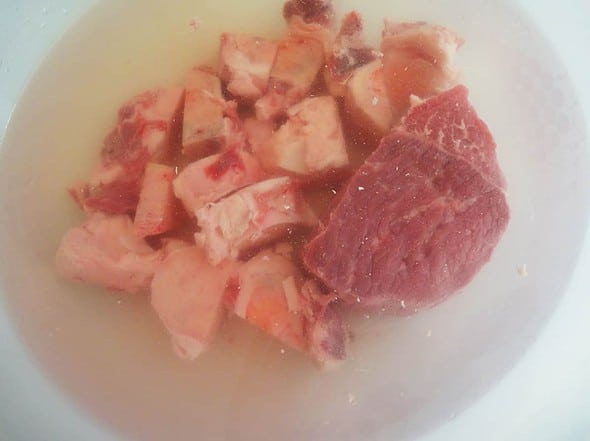
- Rinse bones in cold water a couple of times to remove any bone chips. Drain the water.
- Boil 14 cups water (3½ quarts) in a large pot
- Put the bones and beef into the pot of boiling water. Boil for about 10 minutes.
- Turn off the heat and take out the bones and beef. Get rid of the water.
- Rinse and drain the meat in cold water to remove the excess fat.

- If you only have one pot to use, clean it thoroughly with kitchen soap.
- Put the bones and the beef back into the pot
- Add about 12 cups of water (3 quarts), 1 medium size onion, and 1½ pounds of peeled radish to the pot. Bring to a boil over medium heat.

- When it starts boiling about 20-30 minutes later, lower the heat to simmer for 3 hours.
- Turn off the heat and take the beef and radish out of the pot. Leave the bones behind.

- Put the beef and radish into a bowl.

- Pour the brownish broth out of the pot and into a large bowl. We’re going to keep boiling these bones and collect the broth into this collecting bowl as we go along. Keep it in the fridge during this process.
If you have a larger pot, you could keep boiling the bones and adding water over hours and hours, but with a small pot we need to do it in stages and collect in this collecting bowl. - Fill the pot with water again (about 3 quarts) and boil over medium high heat for about 20 minutes. When it starts boiling, lower the heat and simmer for 2½ to 3 hours.
- Turn off the heat, open the lid, and pour the broth into the collecting bowl. It will be a lot whiter than the first time we poured it out.

- Fill your pot with water again and boil over medium high heat for about 20 minutes. When it starts boiling, lower the heat and simmer for 2½ to 3 hours.
- Turn off the heat, open the lid, and pour the broth into the collecting bowl. This time it will be really white, but thin.
- Cool down the collecting bowl and cover it with plastic wrap. Keep it in the refrigerator for several hours until all the fat floats to the top and gets solid. This is going to be our bone soup.

Let’s serve!
- Take the bone soup out of the fridge. Remove the solid fat from the top with a spoon or strainer.


- Slice the cooked beef thinly, about 1/8 inch thick. Cut radish into ¼ inch thick slices
- Reheat the bone soup and ladle the soup into a serving bowl.
- Add a few slices of the beef and radish to the soup. Serve with warm rice and kimchi, along with chopped green onions, minced garlic, kosher salt, and black ground pepper.

- Add some salt, chopped green onion, and black ground pepper to the soup. Mix it well with your spoon. You can add warm rice to the soup and enjoy!


 *tip: The amount of salt you put in depends on your taste, but I suggest starting with 1 ts and adding more if it’s too bland.
*tip: The amount of salt you put in depends on your taste, but I suggest starting with 1 ts and adding more if it’s too bland.
Spicy version:
- Tear about 1 cup worth of cooked beef into thin strips. Put them in a mixing bowl.
- Add 2 tbs chopped green onion, 2 ts soy sauce, 2 ts hot pepper flakes, a pinch of black ground pepper, and 2 ts toasted sesame oil. Mix it well with a spoon.

- Ladle the boiling soup into a serving bowl and add a few slices of radish and the mixture of seasoned beef.
- Serve with warm rice, kosher salt, and kimchi.
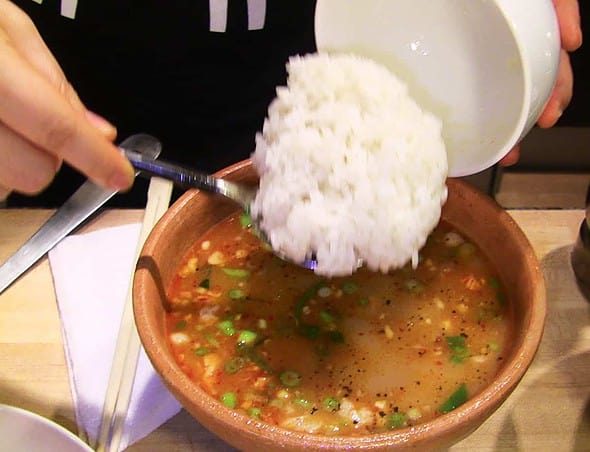
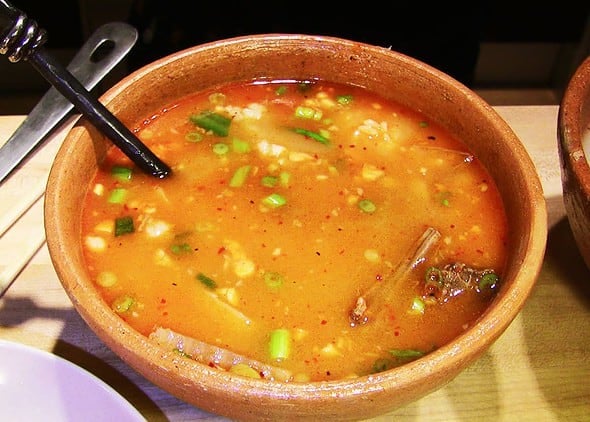
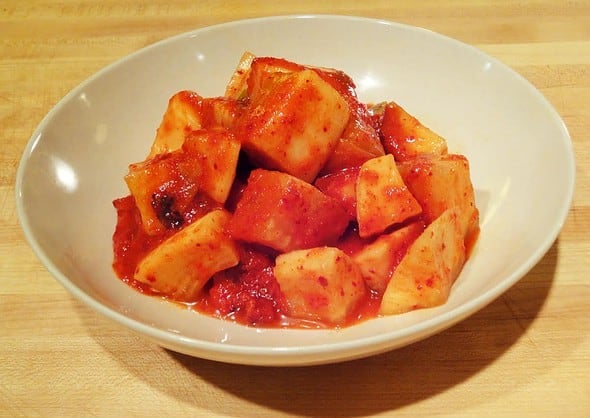
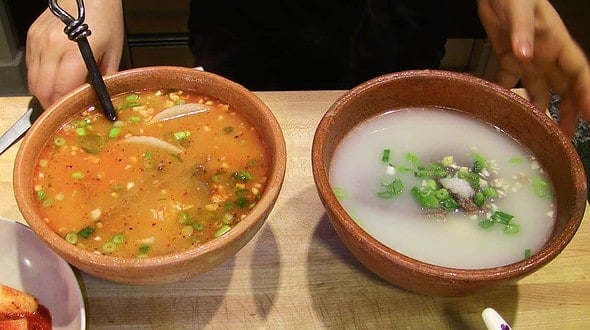
Buy this recipe's ingredients online
I really like Weee! they deliver quality packaged and fresh Korean ingredients to the continental USA. Cheaper and better than Amazon! Check them out!



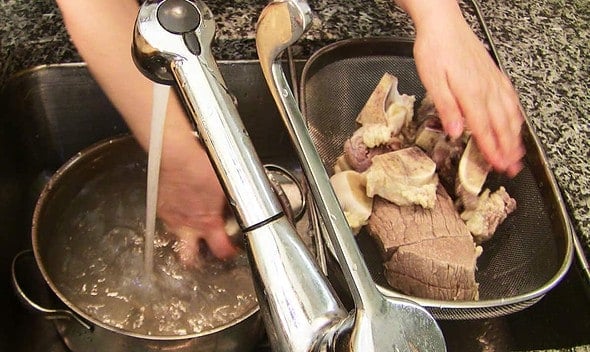
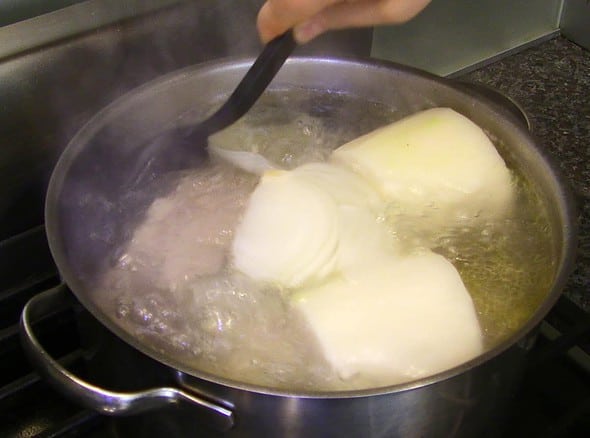

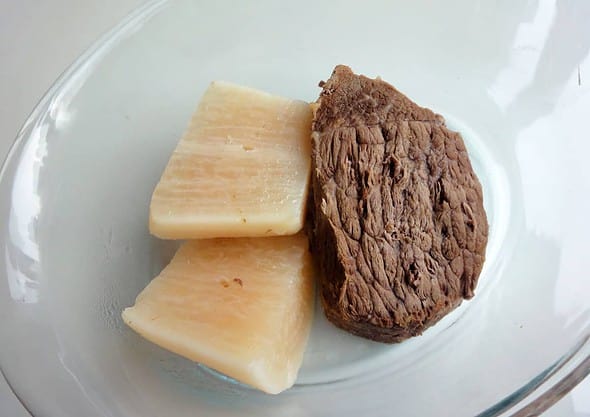
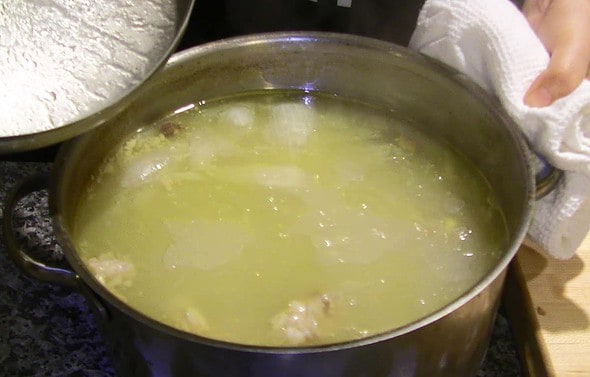
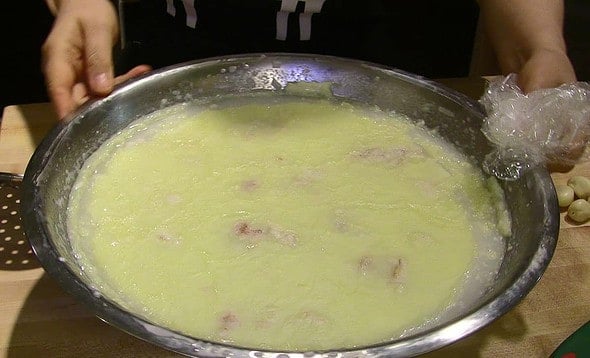
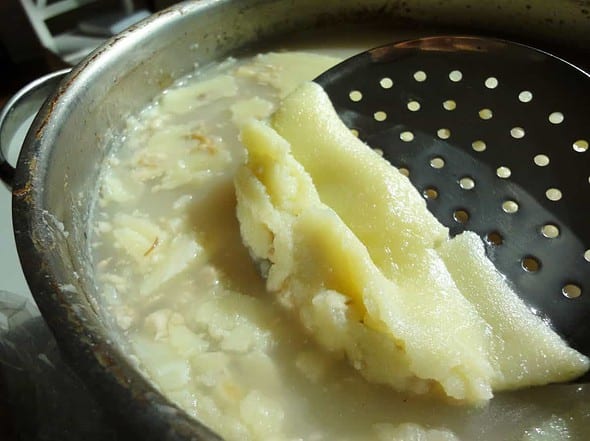
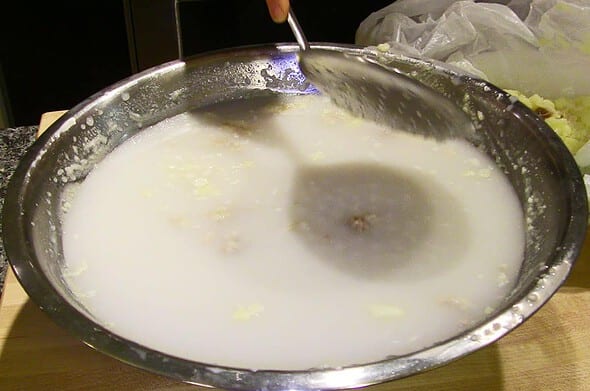
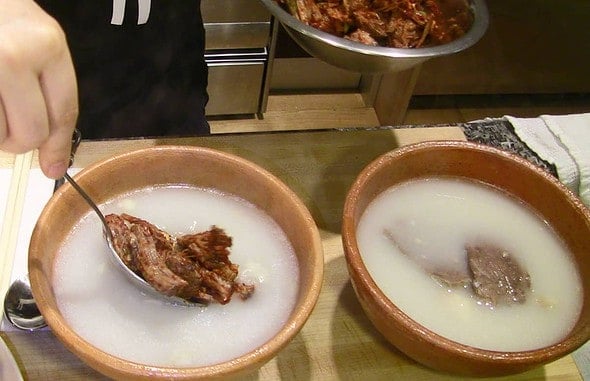
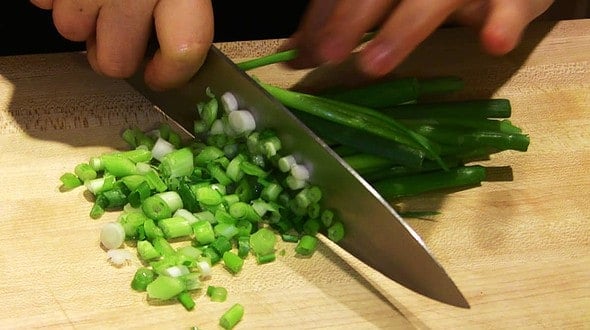
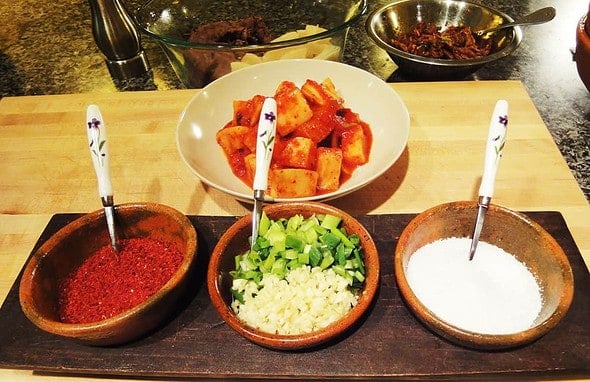
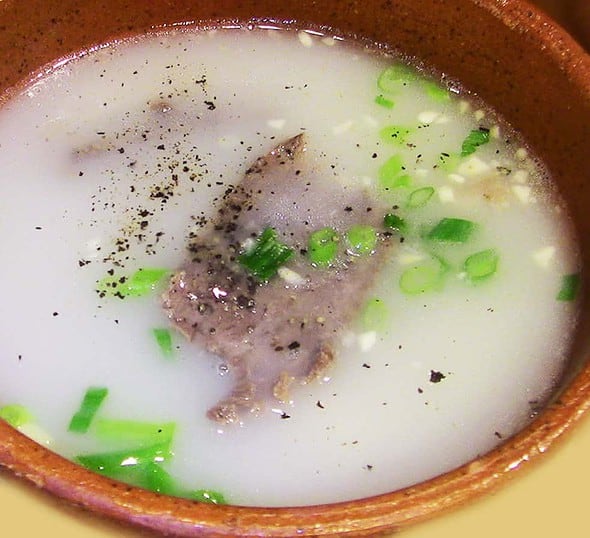 *tip: The amount of salt you put in depends on your taste, but I suggest starting with 1 ts and adding more if it’s too bland.
*tip: The amount of salt you put in depends on your taste, but I suggest starting with 1 ts and adding more if it’s too bland.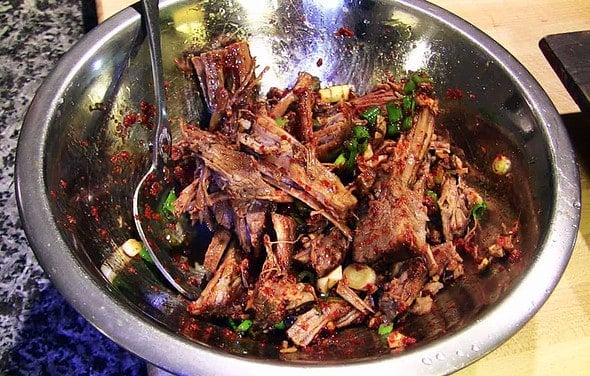


![[OTTOGI] Premium Roasted Sesam...](https://m.media-amazon.com/images/I/41DixbNS9AL._SL160_.jpg)


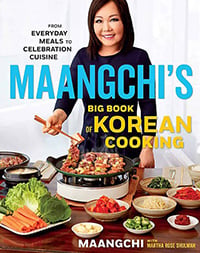




















Hi, would I be able to use pork neck bone in place for ox tail bones for the bone soup? I understand that is not authentic but I got the pork neck bones by mistake but was really wanting to make a more natural flavor than the spicy version of the soup. Thank you and look forward to hearing from you.
Hello Maangchi-ssi, You must have a very large cold storage fridge for all your fantastic recipes! I would like to imagine how big and well-stocked your kitchen area must be!!! I am a follower and I make a lot of your foods. Thank you for teaching me to eat right and lose weight, Korean-style!!!
I tried making this the other day and went to finish it this morning. I was cleaning in another room and evidently had the heat too high so It is currently scorched to the bottom of my pot. Please don’t make my mistake and watch your broth. I set a timer for 2 hours and it only took one to ruin it. Be careful!!!
Hi, so excited to make this dish!! But I don’t really want to use corn syrup, for health reasons. Is there a substitution you can recommend? Anyone?? Thank you!
Does this recipe freeze well? If I spend the time making the broth I would love to be able to freeze a bunch of it in individual serving sizes.
What do you think?
Also-thank you for all of the hard work you put into sharing Korean food with the world. I lived in Korea for a year from 2013-2014 and the food is what I miss the most. You’ve helped me keep it in my life.
Much love to you!
Jill
Hi Jill,
Yes, freezing bone broth is a great idea. I often freeze my bone broth, too. You can keep it in the freezer up to 1 month.
Dear Maangchi,
I would love to make this soup! I was wondering if you have a recipe using an Instant Pot to shorten the cooking time?
I don’t have an Instant Pot but I sometimes use my pressure cooker to shorten the cooking time, but I always boil it in a pot on the stove afterwards, to get a milky broth.
How long would you cook it in a pressure cooker for?
where can I find the recipe for making stock or broth? thanks ^^
Maangchi, my wife and I love your videos.
Made this today, I followed the recipe completely minus the fact that I soaked the bones for 2 hours. Looks so great and smells heavenly. Cant wait to try it.
Just some clarifications?
Do we leave the onion in?
And
If we want to just use one pot, is there a different way to cook it or just leave bones (and onions) in he pot and keep pouring water into the same pot?
I leave the onion in and it disintegrates / disappears.
I use one very large pot and just keep an eye on the water. It makes it harder to skim and discard the fat, unless you wait until after you put it away in containers and refrigerate. But, as long as you do the first boil, discard, and clean the pot, you’ll be fine!
Hope that helps!
Hi Maangchi, I’ve tried you recipe and it’s so delicious! I want make more soup for my family. but my question is, after I make more soup, can I keep the soup in freezer to freeze it for keeping it for long time, like a month?
Yes, you can freeze the bone soup up to 1 month.
Hi Maangchi,
Can the beef and radish be frozen in the soup up to a month as well? What would you recommend?
Thanks!
Hi!
I’ve been wanting to try this out for ages and starting now. My water after taking out the beef and mu didn’t reduce. Are we meant to keep the lid on or off? I read that we take it off but I don’t understand how the water is meant to reduce?
If anyone is interested:
Sagol bone stock could be a valuable calcium and protein source by boiling for at least twelve hours with ten times of water (wt/wt).
Source: Journal of the Korean Society of Food Science and NutritionVolume 11, Issue 3, 1982, pp.47-52
An Experiment in Extracting Efficient Nutrients from Sagol Bone Stock
Park, Dong-Yean; Lee, Yeon-Sook;
So my parents were right! This soup is GOOD for me!
Hi! I love all your Korean recipes. My boyfriend and I got hooked onto Korean food while addicted to KDrama! I just want to know, is it possible making this and galbitang using pressure cooker? Thanks!
I grew up on this, and cannot wait to attemp it on my own. I just didn’t realize the steps Eoma took to make it so milky white. I thought she threw the oxtail, radishes, seasonings, and water in a pot, and poof! I guess a little more goes into it! Thanks for all the great recipes!!!
Hi Maangchi, Can I use ALL ox tail instead of ox bone and beef flank? So, 4.5 or 5 lbs of oxtail instead?
Will it make the soup less flavorful if I don’t use the beef flank?
Yes, you can! You can skip flank steak and add more ox tail.
Thanks! I am going to try making this over the weekend. I miss the gori–gomtang my grandma used to make and I want to recreate it! You’re the best.
Bye!
Hi Mikko,
I prepare gori-gomtang quite often – I don’t always use seolleongtang, chicken-stock works nicely, too; ox-tail is more tasty and better for a hearty soup than any other part. “My” recipe is roughly the same as for galbitang – influenced by gomtang ;-); sometimes I use gori and galbi together. I use less water/stock and a pressure-cooker or a crock-pot (depends on how much meat I have to prepare and how much time there is).
Serve with kkakdugi, chives, garlic cut in slices (lengthwise. Lots of! ;-)) with a little sesame-oil, sesame-oil with salt, black pepper, rice and kkaennip.
That’s about how they serve it in a small restaurant at Song-do Haepyeon in Busan – not the fancy tourist-place (“Song-do Gori-chip”), but the small, modest place west across the street, further away from the beach. You find it on daum.net – “Nam Ch’on Seolleongtang ( 남촌설렁탕 )” is the name of the place.
Best Gori-Gomtang ever!
Bye, sanne.
I definitely made the mistake of using a crock pot, and my broth was still a light brown in the last round of water. Is it still edible even if it’s brown and not the beautiful, milky white?
yes, of course you can eat it.
I live alone I’m too busy to make ox bone soup
When are you going to post ox tail soup?
I’m waiting.
Hello maangchi. I love this recipe and i want try it. Can you help me?. I want to ask you about what kind of ox bones it is? If it is leg ox bones, should i discard the skin from bones?, cause in my country the leg bones is always with the skin. Sorry if my english bad. :)
My broth turned yellowish/brown, I don’t know what I did wrong, I tried to boil it for longer and high heat and it didn’t help :(
you probably didn’t boil the bones enough the first time (when you discard the water).
the point of this part is to boil out most of the blood from the bones. if you don’t boil it long enough, the soup turns a brown color instead of opaque.
There are two things that guarantee white colour:
1. All traces of blood have to be removed. This is why soaking bones and rinsing them after the first boil is so important.
2.You have to actually boil the broth instead of simmering it. Unless the temperature is high enough to extract minerals from the bones it will never turn white, even after 10 hours.
yes, it’s normal. As mooshoofooie mentioned, the brown color comes from blood. Keep boiling over low heat and pour it out to a pot, then add water and boil it again. The 2nd batch will turn out milky white broth. Then pour it into the first batch. The color will be ok. If you boil 3rd batch, the color will still be milky but thinner. Making bone soup never fails if you keep boiling.
Can I skip the radish?
yes, but let’s say us Koreans don’t recommend it.
we say boiling soups with radish gives the soup a smooth taste.
only when you eat soup with and without can you really understand what we mean. :-)
Instead of beef flank can I use sahtae beef?
Also if I want to make 3 servings instead of 6 should I boil for half of the time or the same time?
Yes, you can use satae part (beef shank).
Hi,
Mine was good but really bland… is it supposed to be super flavorful?
Thanks!
No problem! : ) Keep boiling the broth with the bone over low heat until it gets as thick as you want. Add more water if the water runs out.
Hi Maangchi! I have a question on the recipe. If we cook the beef flank and mu with the bones, and we need to wait overnight for the fat in the soup to solidify, does that mean we need to store the cooked mu and flank overnight as well? In your video you had the soup you made from the previous evening so the mu and flank were used right after cooked. Can we just cook the bone soup with only the bones, and then on the second day, put the flank and mu in the soup and cook together longer before serving?
“does that mean we need to store the cooked mu and flank overnight as well?” yes, keep the cooked beef and radish in an airtight container in the fridge until you serve the soup. “Can we just cook the bone soup with only the bones, and then on the second day, put the flank and mu in the soup and cook together longer before serving?” Yes, you can do that, but cooking radish and beef will take a long time.
dear Maagchi! thank you for your recipe! i was wondering if you can make a video about kkori gomtang (i don’t know if i spell it right, i’m thinking about an oxtail soup)! Thanks a lot!
Kkori gomtang is Korean style oxtail soup. Actually you can use my ox bone soup recipe to make kkori gomtang. yes, I will post oxtail soup recipe someday.
To make the spicy version of this soup, can I use the kimchi red pepper flakes I have?
Or do I need to buy a different kind?
Thank you : )
yes, yes! https://www.maangchi.com/ingredient/hot-pepper-flakes
Thank you soooooo much for this recipe! I am originally from LA and I grew up in the Korea Town area. This is my favorite KOREAN soup, I live here in Oregon now and there are no Korean restaurants so it’s been at least 8 years since I’ve had this!!!! Can’t wait to make my own!
Ok for those of you who are confused about ox bones vs beef bones, they are basically the same. They still call the grocery cuts of bone “ox” still, but it always was just male beef cuts. Nowadays the same male cattle that have been castrated are known as steer. They are used for meat. They are all the same. Beef. The only males not castrated are called Bulls, and they are only kept un-castrated for the sake of breeding (those lucky ones :) so…ox bones are beef bones.
Hi Maangchi, Is this the same as ox-tail soup? Have you tried using a pressure cooker for this? Does it make a difference?
Hello! I made this one with your recipe last month for my friends and they love it! But the thing is, my broth doesnt look as milky as yours.. I wonder why? I followed every instruction you made.. Is it possible that i didnt soak the meat and bones long enough?
That’s normal. yes, the first batch will be brownish but the second and the third batch will be white milky broth. Please read step 13.14, and15 in the recipe.
“Pour the brownish broth out of the pot and into a large bowl. We’re going to keep boiling these bones and collect the broth into this collecting bowl as we go along. Keep it in the fridge during this process.
If you have a larger pot, you could keep boiling the bones and adding water over hours and hours, but with a small pot we need to do it in stages and collect in this collecting bowl.
Fill the pot with water again (about 3 quarts) and boil over medium high heat for about 20 minutes. When it starts boiling, lower the heat and simmer for 2½ to 3 hours.
Turn off the heat, open the lid, and pour the broth into the collecting bowl. It will be a lot whiter than the first time we poured it out.”
Hi! My first attempt in making this soup didn’t turn out milky either but I got a milky one on my second try. I used beef leg bones and boiled it in moderate boil. It is in moderately boiling it that you get the milky results. I also refilled it with water once the level of the water down. I put the soup in the fridge to coagulate the fat and so it made it easier to remove. I put the rest of my soup in the freezer future use. Hope that helps.
hey i was curious about if you could use cow leg bones instead of ox bone will it be ok? By the way the dish looks delicious.
Hi Maangchi!
So I am about to try your ox bone soup recipe but with oxtails instead of regular beef bones. My question is, can I still achieve the white milky broth with these oxtails??
Thanks!
yes, oxtail soup will still be milky.
Hi Maangchi,
Thanks for all the wonderful recipes.
I have a question on step 9 and 10.
9. When it starts boiling about 20-30 minutes later, lower the heat to simmer for 3 hours
10. Turn off the heat and take the beef and radish out of the pot. Put them into a bowl or container. There may be some white milky broth left in the pot. If so, pour it into a large bowl.
Are you saying that after step 9, almost all the 12 cups of water will be gone ? only a small amount left that i can save ?
thanks.
Ann.
Hi Ann,
No, only about half or two-thirds will be gone, so you can save the rest.
This part of the recipe is a little confusing, I’ll rewrite it now to be a little clearer.
Good luck with making delicious Seollongtang!
Maangchi, thanks for the prompt reply.
If i have a 12 quart stockpot, can I just fill it up and let it simmer down to 3 quarts ? will the resulting soup be milky white as well ? That saves a lot of efforts :)
Thanks and Happy Thanksgiving to you !!
Ann.
Is the soup cooked/boiled covered? Thanks.
yes, cook it with the lid closed.
Hi Maangchi! My dad doesn’t eat beef because he’s allergic, and my mum thinks cows are cute, so she doesn’t eat beef either. Will pork bones work also in giving the broth a milky white texture?
I know if I use pork bones instead, it won’t be called Seollongtang anymore, but the soup just looks so nutritious and I want to cook it for my parents. Thanks!
I never tried making this with pork bones, but you should be able to get a milky white broth with them. I’m very curious to see how this turns out, so if you do it, please let me know what it tastes like.
My pork bone soup recipe is here: https://www.maangchi.com/recipe/gamjatang
Can this be made with a slow cooker instead of on the stove?
I guess I can respond to my own question since I decided to try it out. The answer is no, slow cookers do not work. I don’t have an explanation to the reasons why, though (maybe the agitation of boiling water is needed?). The broth came out a deep brown after 12 hrs, so I think slow cooker is a good way to get a western-style beef broth at least. :)
Thank you very much for your update! Good luck with your Korean cooking!